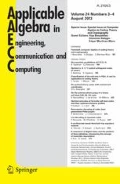Abstract
Starting from an egg, the multicell becomes a set of cells comprising a variety of types to serve functions. This phenomenon brings us a bio-motivated Lindenmayer system. To investigate conditions for a variety of cell types, we have constructed a stochastic model over Lindenmayer systems. This model considers interactive behaviors among cells, yielding complicated polynomials. Using symbolic computation, we have derived explicit relations between cell-type diversity and cell-type ratio constraint. These relations exhibit elliptic curve- and Fibonacci number-related patterns. This is the first example of elliptic curves to appear in the Lindenmayer context. A survey of the rational points and the quadratic irrational numbers on the derived curves has revealed Fibonacci-related periodic and quasiperiodic patterns. Further we have found that in some region, there are only two elliptic curve-related periodic patterns.
Similar content being viewed by others
References
Alberts B., Johnson A., Lewis J., Raff M., Roberts K., Walter P.: Molecular Biology of the Cell. 5th edn. Garland Science, New York (2008)
Bryant P.J., Bryant S.V., French V.: Biological regeneration and pattern formation. Sci. Am. 237, 67–81 (1977)
Caviness B.F., Johnson J.R.: Quantifier Elimination and Cylindrical Algebraic Decomposition. Springer, Wien (1998)
Eichhorst P., Ruskey F.: On unary stochastic Lindenmayer systems. Inf. Control 48(1), 1–10 (1981)
Eichhorst P., Savitch W.J.: Growth functions of stochastic Lindenmayer systems. Inf. Control 45(3), 217–228 (1980)
French V.: Leg regeneration in the cockroach, Blattella germanica I. regeneration from a congruent tibial graft/host junction. Roux’s Arch. Dev. Biol. 179, 57–76 (1976)
French V., Bryant P.J., Bryant S.V.: Pattern regulation in epimorphic fields. Science 193, 969–980 (1976)
Gilbert S.F.: Developmental Biology. 8th edn. Sinauer Associates, Sunderland (2006)
Jürgensen H., Lindenmayer A.: Inference algorithms for developmental systems with cell lineages. Bull. Math. Biol. 49(1), 93–123 (1987)
Kaneko M., Odagaki T.: Selfsimilarity in a class of quadratic-quasiperiodic chains. J. Phys. Soc. Jpn. 62(4), 1147–1152 (1993)
Koshy T.: Fibonacci and Lucas Numbers with Applications. Wiley, New York (2001)
Lindenmayer A.: Mathematical models for cellular interactions in development. I. filaments with one-sided inputs. J. Theor. Biol. 18(3), 280–299 (1968)
Lindenmayer A.: Mathematical models for cellular interactions in development. II. simple and branching filaments with two-sided inputs. J. Theor. Biol. 18(3), 300–315 (1968)
Mishra B.: Algorithmic Algebra. Springer, New York (1993)
Odagaki T., Kaneko M.: Self-similarity of binary quasiperiodic sequences. J. Phys. A: Math. Gen. 27, 1683–1690 (1994)
Rozenberg G., Salomaa A.: The Mathematical Theory of L System. Academic Press, New York (1980)
Silverman J.H. (1986) The arithmetic of elliptic curves. In: Graduate Texts in Mathematics, vol. 106. Springer, New York
Stroeker R.J., Tzanakis N.: Solving elliptic diophantine equations by estimating linear forms in elliptic logarithms. Acta Arith. 67, 165–190 (1994)
Tzanakis N.: Solving elliptic diophantine equations by estimating linear forms in elliptic logarithms. the case of quartic equations. Acta Arith. 75, 165–190 (1996)
Ványi, R., Kókai, G., Tóth, Z., Pető, T.: Grammatical retina description with enhanced methods. In: Poli, R., Banzhaf, W., Langdon, W.B., Miller, J.F., Nordin, P., Fogarty, T.C. (eds.) Genetic Programming, Proceedings of EuroGP, LNCS, vol. 1802, pp. 193–208. Springer, Berlin (2000)
Yokomori, T.: Inductive inference of 0L languages. In: Lindenmayer systems: Impacts on Theoretical Computer Science, Computer Graphics, and Developmental Biology, chap. 2, pp. 115–132. Springer, Berlin (1992)
Yoshida H., Anai H., Horimoto K.: Derivation of rigorous conditions for high cell–type diversity by algebraic approach. Biosystems 90, 486–495 (2007)
Yoshida, H., Horimoto, K., Anai, H.: Inference of probabilities over a stochastic IL-system by quantifier elimination. In: Kotsireas, I. (ed.) Mathematics in Computer Science, Modeling and Analysis of Complex systems, vol. 1(3), pp. 473–485. Birkhäuser (2008)
Yoshida H., Kaneko K.: Unified description of regeneration by coupled dynamical systems theory: intercalary/segmented regeneration in insect legs. Dev. Dyn. 238, 1974–1983 (2009)
Author information
Authors and Affiliations
Corresponding author
Electronic Supplementary Material
The Below are the Electronic Supplementary Material.
Rights and permissions
About this article
Cite this article
Yoshida, H., Miwa, Y. & Kaneko, M. Elliptic curves and Fibonacci numbers arising from Lindenmayer system with symbolic computation. AAECC 22, 147–164 (2011). https://doi.org/10.1007/s00200-011-0143-7
Received:
Revised:
Accepted:
Published:
Issue Date:
DOI: https://doi.org/10.1007/s00200-011-0143-7




